What a great way to avoid the depressing months of November and December! For the first time in my life, I crossed the Equator to visit the—to me—exotic country of Argentina.

A good place to start in understanding someplace new is to look at the geography. A country’s landscape defines its destiny. I got a look at Argentina’s huge plain from the air: Until the city is in view, nothing but green agricultural parcels as far as I could see. No hills, and only over to the far west, the Andes mountains, which I didn’t see until I went down to Patagonia. And that river: the Río de la Plata, so wide one can’t see the other side, and brown as milk chocolate from the sediments pushed down from the tropics up north.
Argentina wasn’t the flashiest jewel in the Spanish colonial treasure: what good is all that grassland compared to the gold and silver up north? In the Natural History Museum of Buenos Aires, I saw skeletons of the giant mammals that roamed these prairies until the invading human population rendered them extinct. (These Indian tribes were in turn made extinct by more recent usurpers—more on that on the Patagonia post.) It wasn’t until the mid 19th- century that the profit this grass could bring, in the form of cattle and sheep, was realised. When the country freed itself from the Spanish yoke, the handful of families who had participated in the liberation divvied up the huge territory and distributed it amongst themselves thank you very much. This created an instant aristocracy. The class divide between the few wealthiest families and the rest of the population has cursed Argentine history all along.
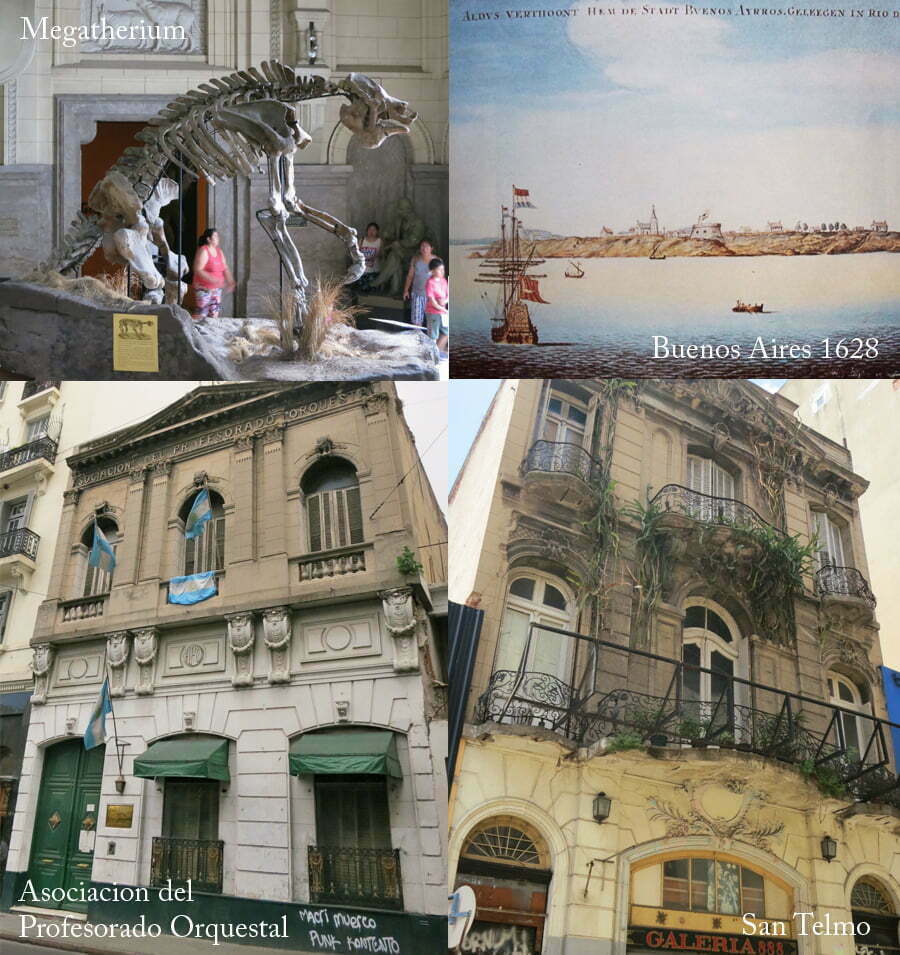
Argentina proudly held its place as third-richest country in the world during the early 20th century thanks to its beef and sheep exports. Alas, the undiversified economy eventually caused great economic hardship as wool products were replaced with synthetics, and unsuccessful efforts to lower beef prices in Argentina created quotas on exports. Not to mention disease and lower world beef consumption.
Unlike a visit to a European capital, my touristing did not take in too many beautiful monuments. Sure, there were plenty of statues of generals on horses, but I can’t say I agree with the old saying that “Buenos Aires is the Paris of Latin America”. To me, it more resembled New York in the bankrupt 1970’s: crumbling infrastructure, and no funds to spruce up the historical sites.In Argentina, the olden days don’t seem so beautiful: most old buildings are slowly decaying, as in the 2 photos above.The buildings that were beautiful, for example, the Galerias Pacífico Shopping Centre, the Palacio Barolo, or the curious Palacio de Aguas Corrientes (a gorgeous shell encapsulating waterworks ensuring there would be no more cholera or fever outbreaks), were built during the days of glory, between 1880 and 1929.

While I was there, I saw dozens of political demonstrations which expressed the anger and frustrations of the Argentines. When the G20 came to town November 30 and December 1, the whole city was shut down (no buses, subway, stores, Milongas…) for fear of anti-capitalist violence. In Spanish class our “frases de la semana” included slang for police.
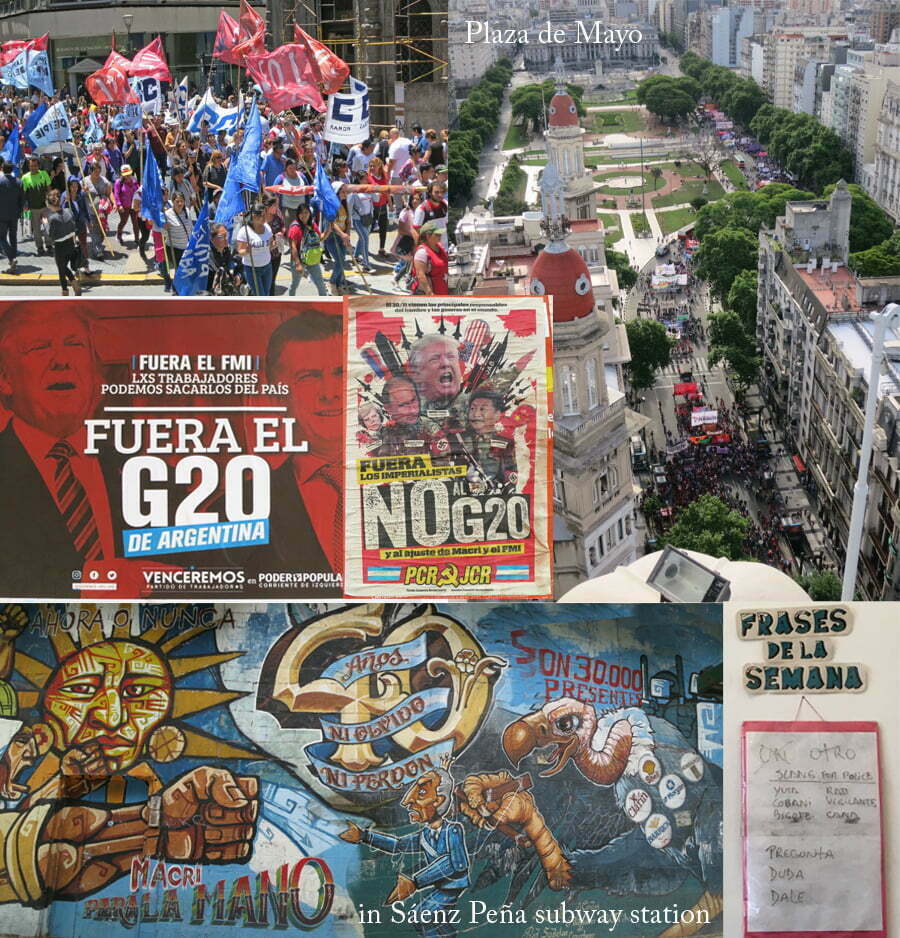
It took me 2 weeks to get used to having the sun travel across the Northern Sky. Since it was almost the solstice, it wasn’t exactly North, but enough so that I consistently took off in the wrong direction when emerging from the subway. In Buenos Aires there was too much light pollution to see the Southern Cross, but I did see it over Montevideo, Uruguay. The moon, I noticed, presents as upside down to what I am used to: as it waxes, it makes a “C” shape; waning, a “D”.
Buenos Aires doesn’t have a lot of parks, but it does have the Reserva Ecologica, which you can see in the aerial photo. On the river, it provides a home for some of the many riparian birds. It also makes a nice place for the Porteños (named after the Port which defines the origins of the city) to jog, bike and picnic. Runners can cool off in the provided mist stations. It abuts the Puerto Madero, which has pleasant walks along the waterfront, where vendors sell street food and salsa dancers enjoy the outdoor venue.
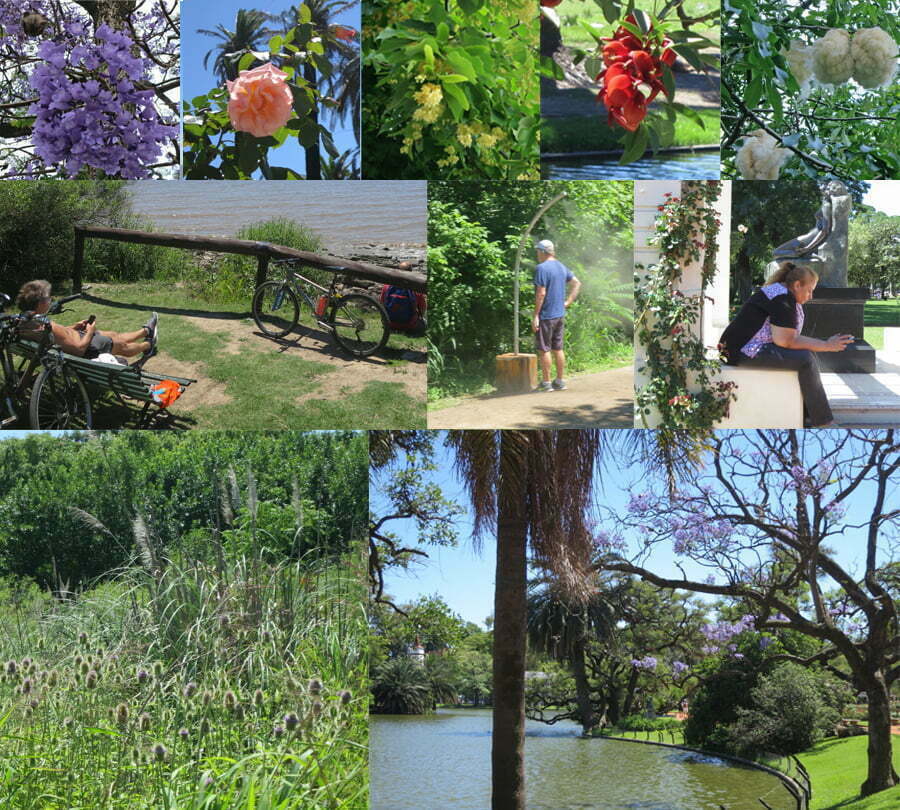
Another large park is in the North section of elegant Palermo. One has to traverse one of the giant avenues (the widest city street in the world is in Bs.As.—Avenida 9 Julio) to get to it. There is a lovely rose garden, water elements, and enough trees and grass to serve the city.
When I first got to Buenos Aires, I stayed with a woman and her young daughter, on a street adjacent to noisy Santa Fe, one of the big east-west thoroughfares of town. I had a nice room and I was grateful to have a local help me in my adaptation to the big city. Neither one of us spoke the other’s language so I stretched my Spanish and pantomime tools. They also had a cat, which was sweet. We were located in lower Palermo. Later on, I switched to an apartment on my own near the Teatro Colón, in a more downtown location. Every day during the whole time I was in Buenos Aires, I made myself little notes with directions indicating subway (“Subte”), bus (“colectivo”) and walking indications. My old brain does not retain much and I depended on these little scraps of paper.
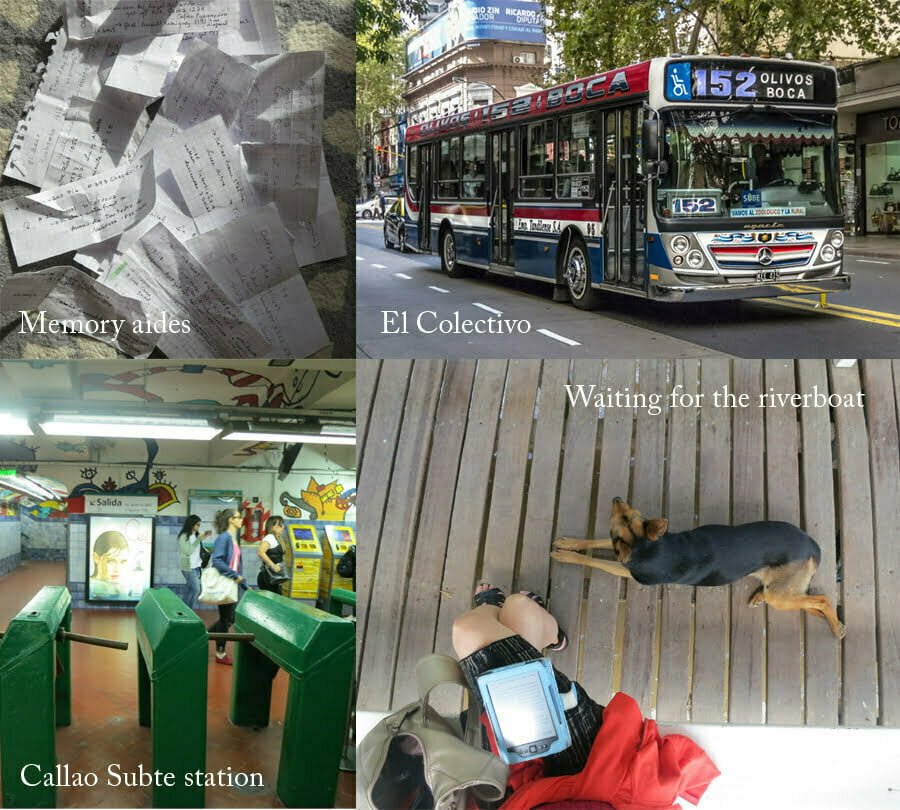
I took advantage of good walking tours to get to know the history and geography of the town. I visited the oldest part of town, La Boca (the Mouth, as in mouth of the Matanza—”slaughterhouse”— river, which is now utterly polluted with heavy metals), which was the birthplace of the city but rapidly lost all its wealthy citizens to fear of Yellow Fever in the late 1800’s. They all moved up to Recoleta and Palermo, which are still the nicer parts of town.

La Boca, and neighbouring San Telmo were left to the thousands of immigrants who flooded the city in the second half of the 19th-century. Its proud politically-radical heritage motivated this part of town to secede from Argentina in 1882 (that didn’t last long).I visited a couple of the “Conventillos”, where hundreds of poor families used to share resources in the abandoned villas. La Boca is recognised as a cultural heritage centre and continues to harbour artists and musicians. It also it the home of the Boca Juniors football (soccer) team. The Argentines are very serious about their football, to make an understatement (to illustrate the power of football: President Macri made his political debut as president of the Boca Juniors).
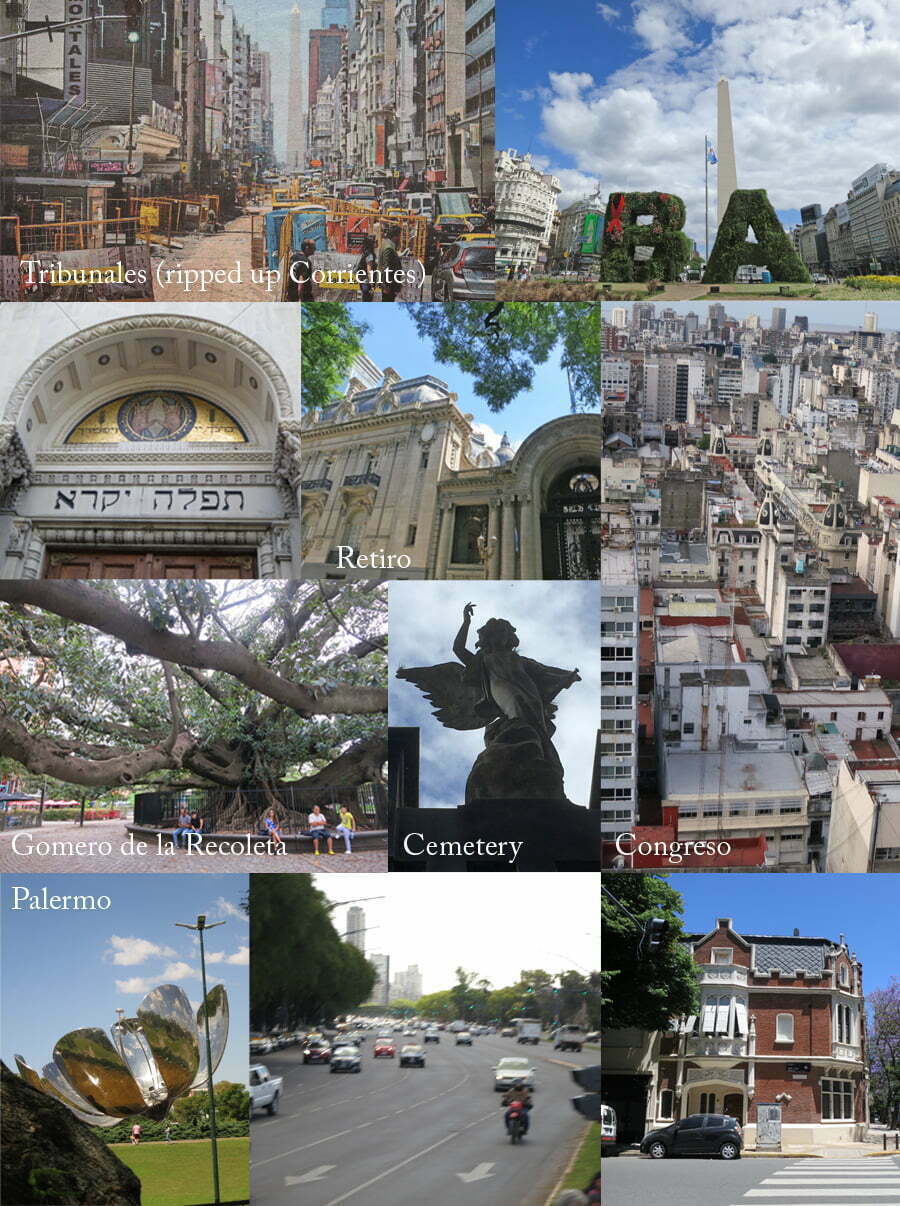
I think the cultural treasure of Buenos Aires is found in the things one can’t see: the music, which is everywhere, and of really superior craft, whether at the opera or with subway buskers; the people, who are affectionate and warm; and the intellect (there’s a bookstore on almost every block). Theatre is very popular and they cherish poets (there’s a poet corner in Parque 3 de febrero with statues of their favourites). The biggest store I went to was an enormous book store in a converted theatre, El Ateneo Grand Splendid. I was lucky enough to attend an opera at the renowned Teatro Colón (some say it has the best acoustics of all the opera houses). While I’m no Bellini fan, the soprano, Anna Pirozzi, and the mezzo, Annalisa Stroppa, brought me to tears with their singing in “Norma”. Couldn’t understand the supertitles (in Spanish) but they sure wrought my emotions! I also was able to attend a (free!) recital of Shubert’s “Winterreise” by the great baritone Victor Torres at the Kirchner Cultural Centre, a place with free dance lessons and expositions.

One day, I made the rather long bus ride up to Espacio Memoria y Derechos Humanos (ESMA), the site of an important detention centre during the dictatorship of the late ’70s and early ’80’s. I think the most shocking aspect of this horrible place (which had been—even during the torture and murder of citizens—a Naval Academy) was how recent this episode of history was. Tapes run showing the 2010 trials with people my age testifying. The Madres del Pañuela Blancos in their distinctive white kerchiefs, though they are dying off, continue to march around the Plaza del Mayo every Thursday, demanding to know what happened to their “disappeared” children.
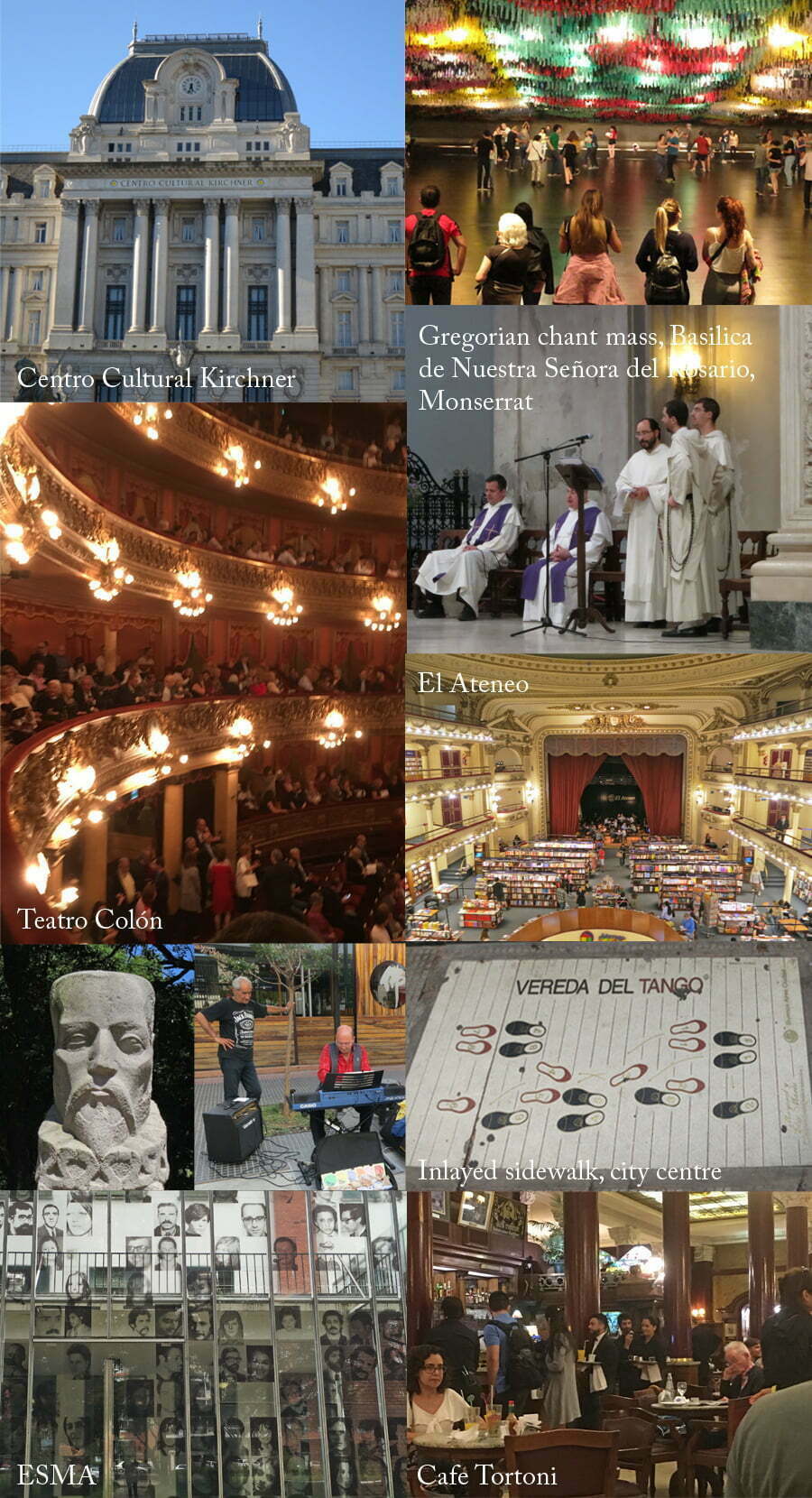
At first I was put off by the long tourist lines in front of the famous Tortoni Café. But when I persevered, along with a friend (who had apparently spent her youth studying for exams at this peaceful place), I was delighted to find that the long wait was worth it: the management wants to ensure that your experience there is just as charming as it was back in the day. They let you stay, chatting or with a book, as long as you want.
Money is a problem in Argentina. The government, trying to put a lid on the rampant inflation, tightens the access to cash. I could only take out a maximum of 4000 pesos (worth about 106 US$; 93 €) at a time, and added an usurious 11% bank charge. Also, the ATMs would typically run out of cash around 3:00 pm. Consequently, any banks that still had cash would have long lines in front (no one complains about the half-hour waits).
The city is very noisy and dirty. While I was there, one of the main thoroughfares, El Corrientes, was being completely repaved (they say it’s because the president’s family is in construction, so he continually rips up the streets), which created more chaos than ever. The sidewalks are made of tiles, which inevitably break and don’t get repaired. Curiously, the fashion seems to be for hideous platform shoes. I imagine there must be a lot of ankle sprains among the Porteñas! The taxi drivers were all super nice to me. They seemed to be the only people who could understand my paltry Spanish, and I always felt proud of myself after a taxi ride.
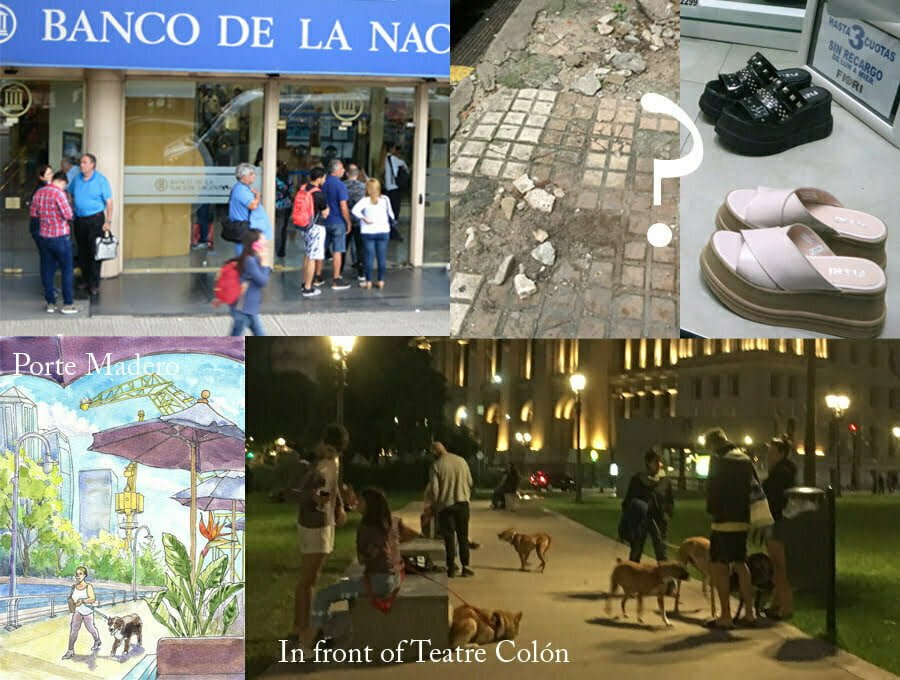
A brief note on the food: As a pescatarian, I was hard put to find something to eat other than pizza or vegetarian empanadas. I did eat at a nice restaurant in Palermo once, and the fish (though fried and too salty) was good. The pastries are not appealing: they are too sweet, mushy and don’t smell like butter, as they should. Bread is very white and also mushy. They also have large candy stores every couple of blocks and people seem to always be eating or drinking sweets. The population doesn’t look in the best of health, probably because of this.
Argentinians sure love their dogs! A common site was to see the dog walkers with phone in one hand and 10 dog leads in the other. Along with the ubiquitous bookshops were a plethora of pet supply stores and veterinarians. Not a whole lot to buy in Argentina except dog food, books and tango shoes.
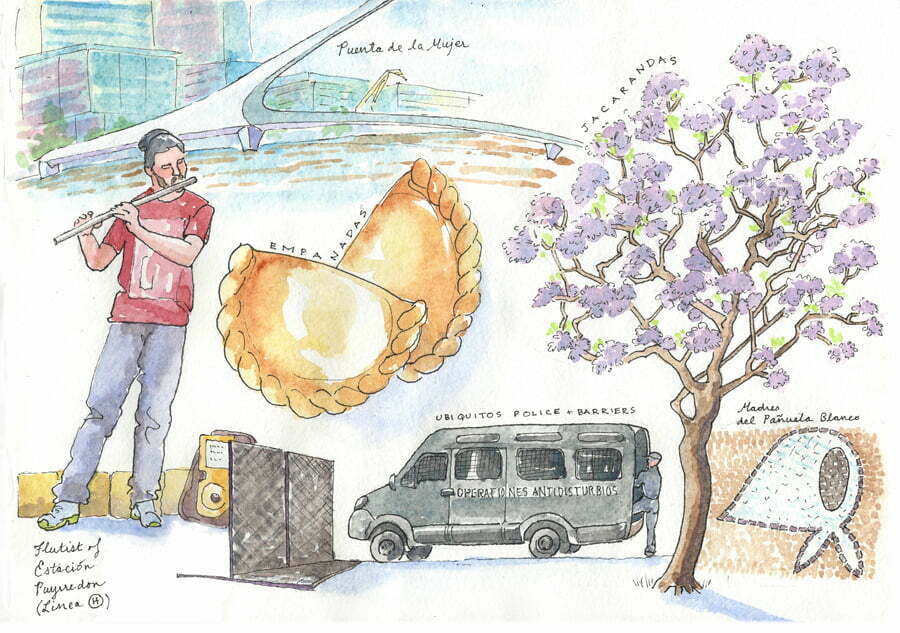
Part of the draw to Buenos Aires for me was tango. The dance and its music were everywhere—from street demos to formal professional shows, along with museums dedicated to tango and its greats, like Carlos Gardel, who first put words to the music and popularised it all over the world. Old and young—at one Milonga I went to they were celebrating the birthday of a 94-year woman, who danced with all the young bucks. I didn’t go crazy with dancing every night, but I tried to go to a Milonga about three times a week. Each Milonga is organised by a different person, and attracts different crowds.
My tango friends will want to know, and yes, I did buy shoes. I liked Souple for their very comfy, flexible shoes (kinda expensive: 4000 pesos = about 100 $). And Soy Porteña for much less expensive (2400 pesos), but nice, open sandals. I wish I had gone the moment I arrived, because I could have ordered custom colours and heel height.
I would check out Hoy Milonga to choose where and when any particular Milonga was held. Every day there are about 30 to choose from! Since I usually went alone, I was too chicken to attempt the more hip & cool younger Milongas, as I doubted I would be asked to dance. When you go to a Milonga in BsAs, the hostess (organisers tend to be women) chooses where you will sit. If she doesn’t know you, you will find yourself tucked out of sight behind a table of regulars. (If you can’t make eye contact in tango, you don’t dance.) As time went by, I was being recognised, and I got to dance more. I met many foreigners who, like me, were drawn to BsAs by the dance. It was fun to share our experiences in this faraway land with others who were equally in a heightened awareness.
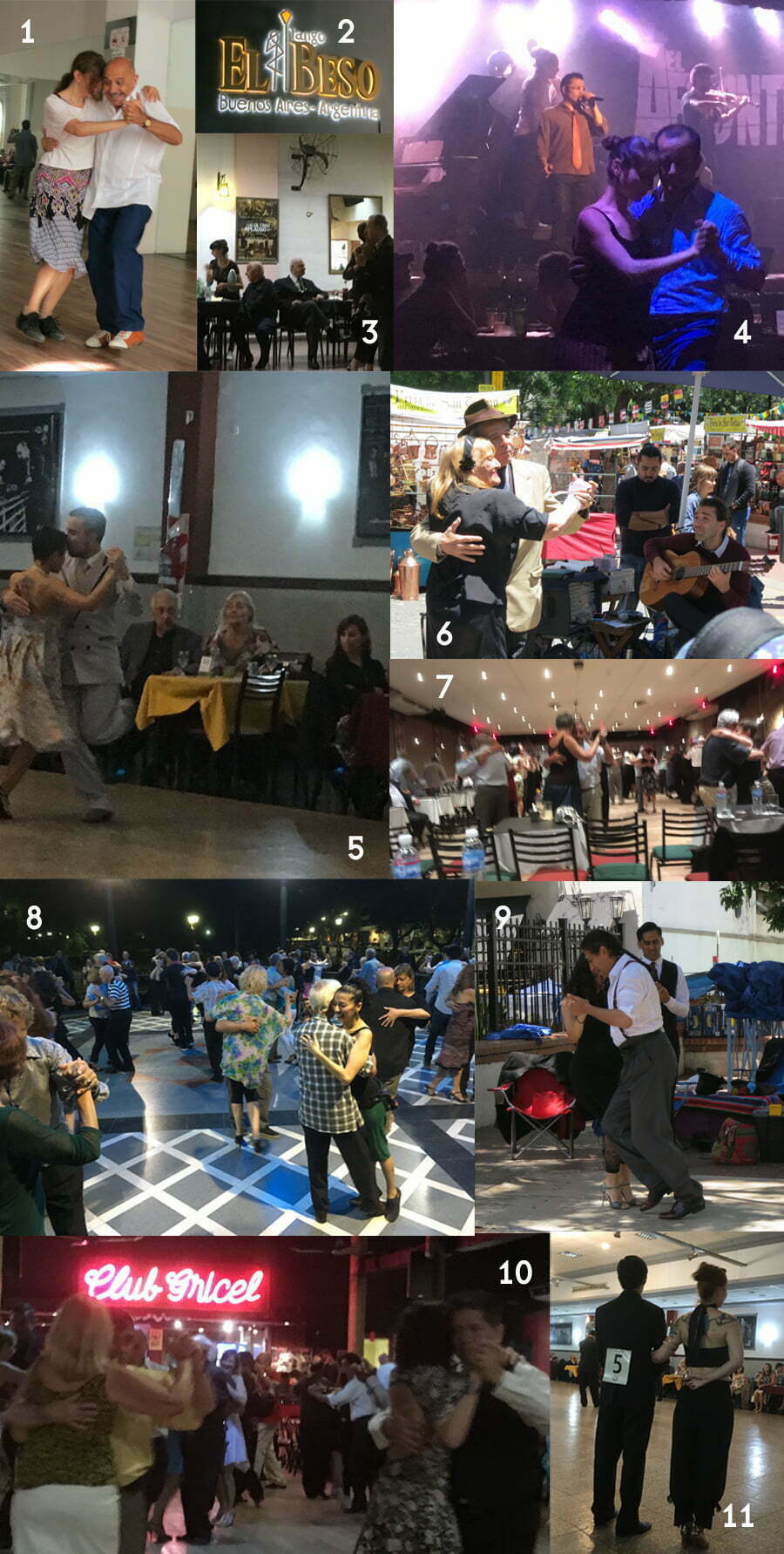
1 Milonga lesson with Diana Mestre & Jorge Firpo at Escuela Mundial de Tango 2 El Beso: just 6 blocks from where I lived 3 Grumpy old men at El Rodriguez, Cristobal 4 Concert at Maldita Milonga 5 Baldoza 6 Plaza Dorrego 7 Obelisco 8 Outdoors at La Glorieta de Belgrano 9 San Telmo 10 Gricel 11 Waltz competition at Baldoza
Before leaving the city for good, I was able to make a day trip to laid-back El Tigre (yes, at one time pumas roamed this suburb). I met a friend who lives there on one of the islands that define this riparian community. I took a 1/2 hour train ride from Bs.As. and then caught a riverboat to our meeting place. We walked along the riverside and had a pleasant lunch at one of the outdoor restaurants there. As someone who grew up near another big river, I felt a nostalgic olfactory recognition in the humidity and rampant vegetation that this delta shares with the Hudson.

Six weeks seemed at once very long and too short. I already miss many aspects of Argentina. I’ll post separate posts on my trips to Patagonia and Uruguay…

So thorough, Diana! I hope you don’t mind if I share this with friends who will appreciate your story.
Sure Susan, go ahead and share. I like the idea that others might enjoy reading about my experiences, which were very moving.
How wondering to discover this post today! Your words and pictures are beautiful, and your candor is delightful. I miss seeing you, but your writing is so conversational that I feel as though we’re in the same room. Besos!
Hi there Nancy, so flattered you like my posts. I try to put things down as I experienced them. I miss you too! Besos a ti
Hi Diana
Glad to see you had a fascinating time in Buenos Aires… Recognised a few of the places from your descriptions, the fabulous drawings and the photos… and looking forward to hearing all about Patagonia too…
Kind regards
David
Thank you for looking at my blog—I just send my thoughts out into the ether like messages in a bottle and really don’t expect anyone to look at them. I’ve finished with the posts on Patagonia, which I loved (thank you for your advice on this place).
Thank you Diana dear for taking time to put together this fantastic résumé of your stay in Buenos Aires! I love your drawings and the moments you capture with your camera. Beautiful indeed with the luxury of having all your comments written out with simplicity, skill and authenticy. To be shared for sure!! Keep up the messages in the bottle for our pleasure! oxo
Muy bello, ameno, diverso, instructivo relato de tu estancia Diana. He comprendido globalmente sin traductor buscando algunas palabras en el ‘tumba burros’… Tus originales dibujos, tus fotos, la presentación muestran tu mirada astuta, perspicaz, pizpireta del alma de Buenos Aires. Muchas gracias Diana por este enriquecedor ‘taco de ojo’ justo antes de mi partida a esas latitudes. Con admiración, R
Gracias mucho Rosa! Aprecio especialmente tus pensamientos y espero escuchar tus proprias impresiones de B.A.